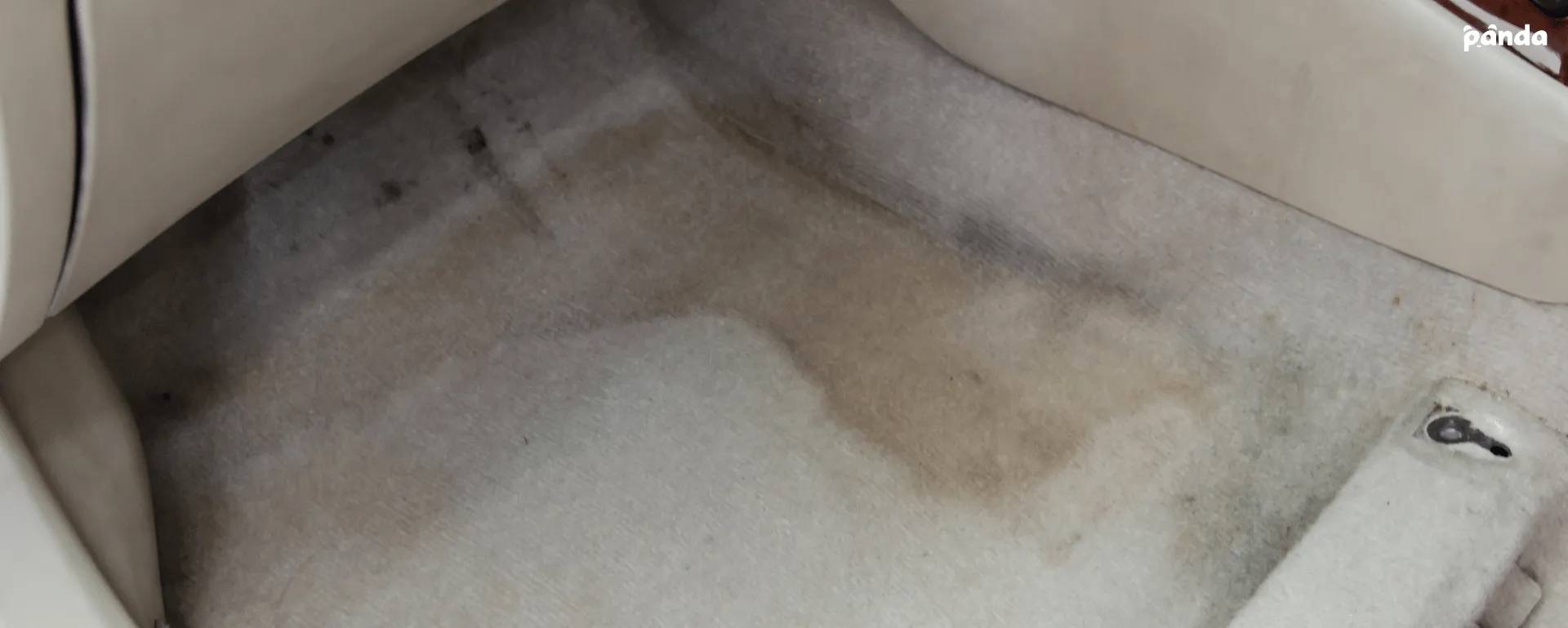5 Effective Ways to Get Mold Out Of Your Car and Carpet
Learn how to get mold out of your car with our detailed guide. Follow our easy steps to keep your car mold-free and comfortable! Learn more with Panda Hub for all of your car care needs.

Written by:
Parham Koukia
Reviewed By:
Editorial Team
Published: May 30, 2025
Updated: September 30, 2025
Use AI to summarize this article:
Discovering mold in your car interior is not only gross but also a potential health hazard. Mold can cause allergic reactions and respiratory issues. The longer it remains in your car, the harder it becomes to remove it.
Addressing mold as soon as you see it is crucial to maintaining a clean and healthy car to drive in.
Keep reading for the steps of getting mold out of your car and preventing it from returning, ensuring every ride is safer and healthier.
How to Get Mold Out of Car Interior: Step-by-Step
Mold can be disgusting! It is dusty, smelly, musty, and can even cause serious health problems.
Before you begin to clean mold you need to have protective gear like a mask and rubber gloves to protect yourself from inhaling mold spores.
Preparation for Mold Removal
Now, that you are ready to tackle that unwanted guest in your car, gather the following supplies for further processing:
- White Vinegar
- Baking Soda
- A spray Bottle
- Microfiber Towel
- Clove Oil
- A soft-bristled brush
Initial Cleaning
- Remove all items from your car, including the floor mats, seat covers, and personal belongings. This will make it easier to access moldy areas.
- After removing all the items, use a vacuum cleaner to remove loose mold spores and prevent them from spreading further. Pay extra attention to carpets, seats, and crevices.

Deep Cleaning
There are different ways to get rid of mold from your car. You can choose any of the following 5 methods depending on the products you have:
1. White Vinegar Solution
White Vinegar contains acetic acid, which is known to be effective in killing about 82% of mold species. The acidic nature of the vinegar helps break down mold particles and eliminate the spores.
- Fill a spray bottle with a mixture of white vinegar and water (1:1 ratio).
- Spray the cleaning solution generously on the mold areas. Focus on areas with visible mold growth and avoid oversaturating the fabric to prevent moisture buildup.
- Let it sit for 20 minutes and scrub the area using a scrub brush to work the solution into the fabric or surfaces.
- Finally, rinse the areas with clean water and wipe down the surfaces with a microfiber cloth to remove any remaining residue.
- Make sure to dry your car’s interior thoroughly after the process.
2. Baking Soda for Stubborn Spots
Baking soda is a natural cleaning agent that not only scrubs away the mold but also neutralizes the odor.
- Sprinkle baking soda on particularly stubborn mold spots.
- Let it sit for 10-15 minutes and use the scrub brush to work it into the fabric or surface.
The abrasive nature of baking soda will help remove the stubborn spots of the mold.
3. Clove Oil
Cove Oil is exceptionally high in Eugenol, a chemical constituent that is known to effectively kill mold spores.
- Mix a few drops of oil with water in a spray bottle and spray the mixture onto the moldy areas.
- The antifungal properties of clove oil not only kill mold but also prevent it from returning.
- For tougher mold spots, mix a few drops of clove oil with some baking soda and scrub the area with a brush after applying the clove oil solution.
4. Special Mold Remover Products
Commercial mold cleaning products are designed to target and eliminate mold effectively. These products often contain powerful chemicals that penetrate deep into surfaces to kill mold spores.
Make sure to follow the instructions carefully for the best results.
Generally, you’ll need to spray the product on the affected areas, let it sit for a while, and then scrub or wipe away the mold.
5. Professional Detailers
Sometimes, mold infestations are too severe or widespread for DIY methods. In such cases, only professional detailers can help you get rid of it.
Professional detailers have specialized equipment and expertise to handle extensive mold problems.
If you are not sure about when to call a professional detailer for car molds, look at these warnings:
- Recurring mold growth that can’t be prevented
- Black, green, or white mold stains in splash-like patterns
- Lingering musty smells even after thorough cleaning
- Experiencing nausea and breathlessness inside or while exiting the car
Hiring a detailer for an interior detailing service can save you time and ensure that mold is completely eradicated, preventing future growth. If you’ve tried multiple methods without success, or if the mold covers a large area in your car, contact a professional car detailer near you and get your job done.
How To Prevent Mold Regrowth
Removing mold from a car is a difficult task. Those who have dealt with it know how challenging molds can be. One wrong step and you will risk spreading mold spores throughout the interior, making the car unsafe to drive. Your job is not done once you tackle a mold infestation; preventing its return is equally important.
Here are a few things to prevent mold regrowth inside your car.
1. Minimize Moisture
Moisture is mold’s best friend. Start by protecting your car from damp weather. Ensure there are no leaks in your car that could allow water to seep in. Check around windows, doors, and sunroofs for any sign of water intrusion.
Additionally, you can also use a dehumidifier or moisture-absorbing packets to keep the interior dry.
2. Ventilation
Good ventilation is key to preventing mold. When parked in a safe area, leave the windows of your car slightly open to allow air circulation. This helps to reduce moisture buildup inside the car. Regularly airing out your car by opening all the windows on a sunny day can also be an effective way to prevent mold regrowth.
3. Regular Cleaning
Maintaining a clean car is essential. Regularly vacuum your seats, mats, and carpets to remove dirt and debris from the car’s interior. If you have a habit of eating inside your car, clean up the spilled drinks and crumbs right away, as the spilled food serves as a great substrate for mold growth.
4. Proper Storage of Items
Be mindful of what you store in your car. Avoid leaving wet items inside as they can create a perfect environment for mold to thrive.
If you frequently transport items that might get wet, such as gym clothes or beach gear, make sure they are dry before leaving them in the car. Or, you can also use waterproof bags or containers for such items to prevent moisture from spreading.
5. Use Mold Inhibitors
Consider using mold inhibitors specifically designed for car interiors. These products create a barrier that prevents mold spores from taking hold and growing. You can find mold inhibitors in sprays, wipes, or even air fresheners. Regular application of these products, especially during humid months, can be an effective preventive measure.
Storing a car for a long time? Here's how to prepare car for long term storage.

Causes Mold to Grow in Your Car?
Mold loves to grow in damp and humid environments. Some of the most common ways that mold can grow in your car interior are:
- Driving in wet weather and keeping your windows open
- Leaving damp products in the interior
- Poor ventilation or a lack of air circulation inside the car
- Parking a car in a humid environment
- Spilling food and liquids on the floors and seats
Out of all these, the most common cause of mold is moisture. Once the mold starts growing inside your car, it spreads quickly to all other parts. So, it's important to take immediate action for mold removal.
As soon as you see any sign of mold, like a white and black appearance on the seats and floor or a moldy smell in the car, follow these quick and easy steps with your household products to remove mold.
Conclusion: How to Fully Remove Mold From Your Car Interior
Removing mold from a car interior might seem hard, but it’s not impossible. With the right approach, you can keep your car mold-free and safe. Keeping your car clean and dry will not only preserve its value but also ensure a healthier driving environment for you and your passengers.
If any of the DIY hacks don’t work for you, you can always contact a nearby car detailing service provider for professional detailing services.
Professional detailers use advanced techniques, specialized equipment, and harsh chemicals to tackle even the toughest mold problems, ensuring your car is thoroughly cleaned and protected from future infestations.
Frequently Asked Questions
Is Mold in a Car Dangerous?
Yes, mold can be dangerous as it can cause health issues like allergies, respiratory problems, and other symptoms of skin and throat irritations.
Can Mold be Removed Completely From the Car?
Yes, with proper cleaning techniques and specialized products that target mold and mildew, mold can be completely removed from the car.
Will Car Detailing Remove Mold?
Yes, professional car detailing services often include car mold removal as a part of their interior cleaning services. A professional detailer uses specialized products and works on every nook and cranny of your car to eliminate mold.
How Do I Stop Mold from Coming Back in My Car?
Keep your car dry and regularly clean and vacuum the interior to prevent mold from coming back. Additionally, since mold loves to grow on moisture, ensure good ventilation, fix any leaks, and address moisture buildup promptly to stop mold regrowth.
What Happens If You Get Mold in a Car?
If you get mold in a car, it will not only damage your car’s interior but also cause health risks like respiratory issues and allergies. So, it is important to remove mold completely and clean your car regularly to prevent mold from reforming.

Parham Koukia
Lead Car Detailer / Operations Manager
With nearly 15 years of hands-on detailing experience, Parham has become a trusted authority in the auto care world. His work is regularly spotlighted in leading outlets like CNN, GoBankingRates, and Family Handyman. Parham likes to share his knowledge to offer in-depth tips on equipment selections, seasonal car care, and some secret car cleaning tips used by detailers in the real world!
Read more
